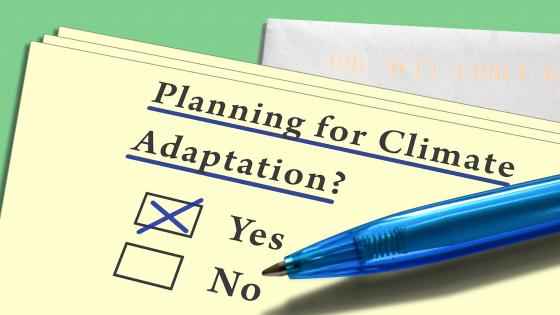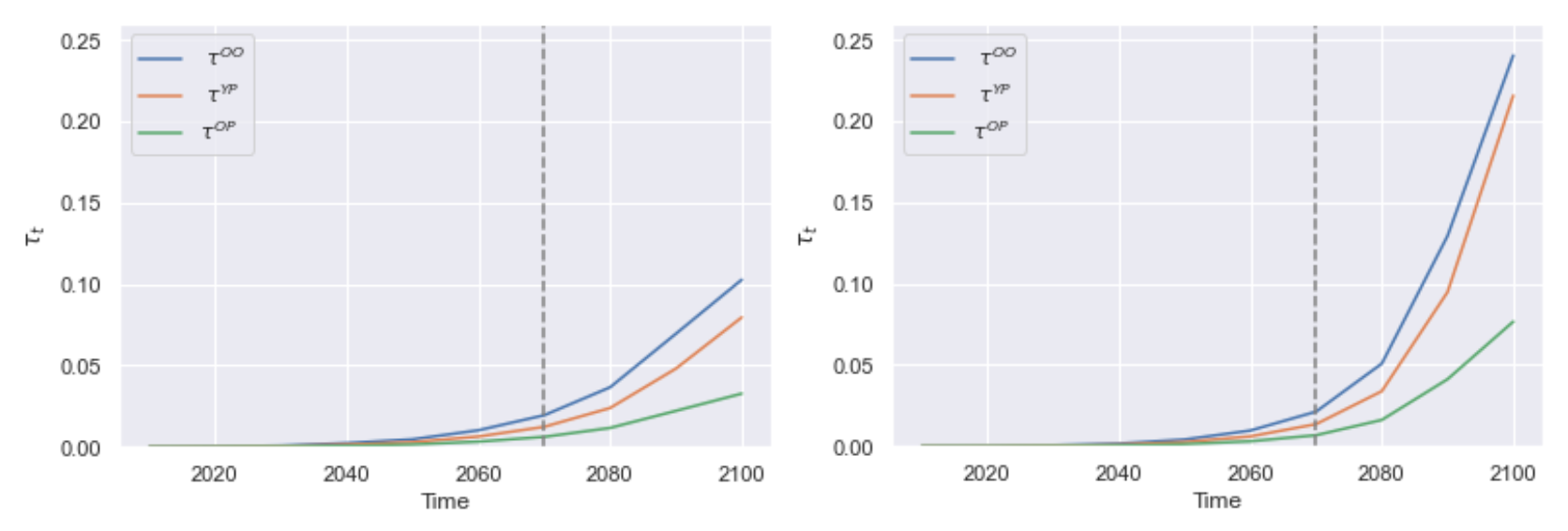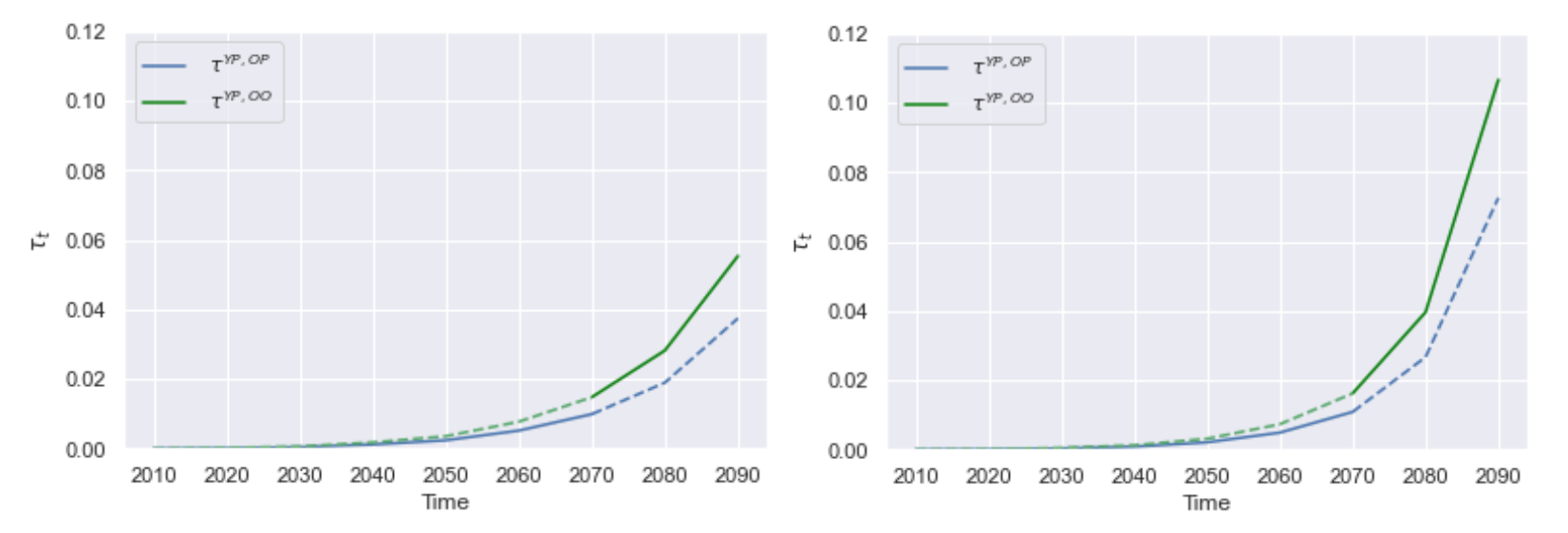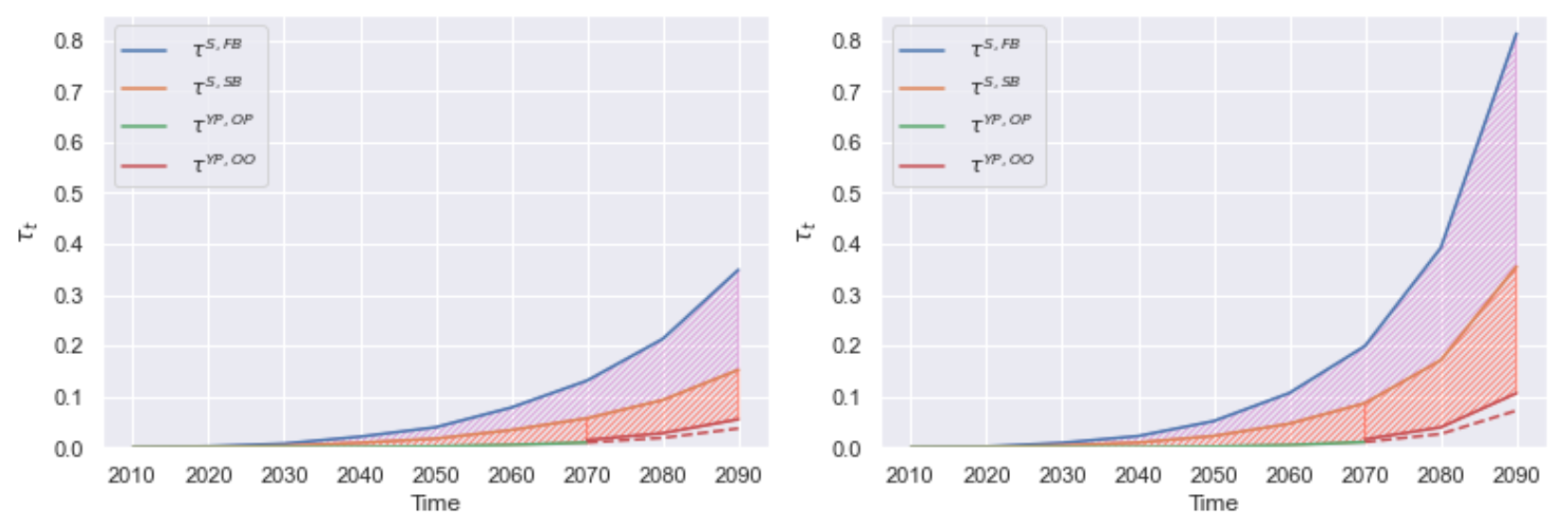Climate mitigation and the green transition are slowly picking up. Global warming will thus continue in the coming decades. As a result, the sea level and the risk of extreme weather events will continue to rise in the near future. There is thus an urgent need for large-scale investments in public adaptation to limit residential and environmental losses from global warming.
However, many people and corporations in societies in Europe, the US, and elsewhere doubt the effectiveness of climate change protection measures. Populist parties have other priorities and doubt the importance of combating climate change. There is thus no political majority in many countries to put aside the funds needed to invest in protection against sea level rise and the risk of extreme weather events. Public investment in protective infrastructure thus requires political support, which currently seems to be lacking. Insufficient adaptation to climate change leads to rising damages and a steady loss of habitat. As global warming continues, there is a greater incentive for government cabinets, parliaments, and senates to make compromises and to form coalitions to get action on climate adaptation. Our objective is to better understand how over time political coalitions can change from those that hardly invest in adaptation to those that do invest substantially in adaptation.
We thus analyse drivers of voter support for public adaptation aimed at containing the effect of climatic impacts. We distinguish between old and young voters and voters who are pessimistic about the efficacy of climate adaptation and those that are not. We do this against a backdrop of rising inequality (e.g. Zucman 2019), which is essential to capture increasingly polarised views (e.g. Voorheis et al. 2015). In a recent paper, we argue that, even if there currently is no majority for ambitious climate protection investments, over time as the sea level rises, the use of public adaptation projects will increase (Van der Straten et al. 2024). This will eventually bring forward a new winning coalition – a political tipping point – where there is a new majority for more investments in climate change protection measures.
Political economy of climate adaptation
We introduce rising climate risk in an overlapping generation model of redistributive technological change (Döttling and Perotti 2017). To get a grip on changing coalitions, we distinguish between young and old people and between those who are sceptic about the efficacy of public adaptation measures and those who are not. The importance of pessimistic climate beliefs about efficacy of climate measures has been established in survey evidence (Douenne and Fabre 2022). We introduce a housing market and risk of flooding (Van der Straten 2023). Climate shocks damage houses and reduce their supply (e.g. due to a higher sea level), thus causing house prices to fall in the short run and to rise in the longer run (as the scarcity effects dominates). Political resistance to public adaptation comes from voters who are pessimistic about the efficacy of adaptation investments and from old voters who won't live long enough to benefit from public adaptation themselves.
We thus obtain a dynamic framework that allows for four different groups of voters and use this to gain insights into the political economy of adapting to climate change. When voting, households support the party proposing an adaptation rate (defined as adaptation spending divided by aggregate income) closest to their preference, with votes cast under a Rawlsian veil of ignorance, thus before they know the realisation of their incomes. However, households are aware of the growing inequality stemming from technological change. This affects their preferences for public adaptation, since it increases the reliance of the economy on protection offered by the government.
Political process
Political parties propose an adaptation rate, which is funded by a flat tax on labour income, competing for votes in each electoral period. The size of the investment in public adaptation is an outcome of this electoral competition, where the majority of votes determines the equilibrium climate policy. We show how support for public climate adaptation evolves over time as climate risk and inequality rise, shifting political alliances across age and class cohorts. We show that the winning coalition shifts in response to the growth in climate damages and the ensuing habitat loss, inducing a political tipping point from a pessimistic coalition of young and old sceptics towards a new coalition of young sceptics and old optimists. This leads to a higher, but still sub-optimal, rate of public adaptation. We will illustrate this now.
Sea level rise overcomes reluctance to act on climate change
For the sake of argument, let us focus on the situation in which there are more old than young voters and pessimistic voters constitute a majority in each cohort. The set of feasible coalitions is then either a political majority of the older cohort, or a coalition of old and young pessimists, or a coalition of old optimists and young pessimists.
If beliefs about the efficacy of public adaptation are sufficiently dispersed, the pessimistic young turn out to be pivotal. The difference between the adaptation rates proposed by the older cohorts of optimists and pessimists then becomes too large. This rules out a coalition of the old. The preferences of young pessimists to either form a coalition with old pessimists or a coalition with old optimists determine the political equilibrium that emerges. If climate risk is sufficiently low, the pessimistic young have weak incentives to support investment in public adaptation. Then, the coalition of young and old pessimists emerges as the winning coalition, with limited investment in public adaptation.
Over time, as climate risk rises, support for public adaptation increases. This occurs as the rise in climate risk increases the value of habitat and hence the value of preventive measures.
Our analysis reveals that this may induce political tipping, as the support by some groups of voters increases at a faster rate than for others. Specifically, young households gain an additional advantage from public adaptation compared to old households, since the youth own the habitat which is to be protected by public investment. Hence, the preferred adaptation rate of the young pessimists increases at a higher rate, gradually moving closer to the adaptation rate proposed by the old optimists.
This is shown in Figure 1, where the orange line for the young pessimists grows faster than the green line for the old pessimists. So, over time the orange line departs from the green line and gets closer to the blue line for the old optimists. This is why, provided that the beliefs on the efficacy of public adaptation are not too dispersed, the political equilibrium eventually tips from a coalition of only pessimists to a coalition of young pessimists and old optimists. This new coalition will spend more on climate change adaptation. Figure 2 shows how this affects the adaptation rate; in particular, it shows the discrete upward jump in the adaptation rate around 2070.
Figure 1 Evolution of the political equilibrium
Notes: The time paths of the adaptation rate preferred by the old optimists (blue line), the young pessimists (orange line), and the old pessimists (green line) for different representative concentration pathways (RCP) scenarios. The dashed, vertical line indicates the point in time at which the political equilibrium tips. The left panel shows the evolution of the bounds under the RCP 4.5 scenario with modest mitigation and emissions peaking around 2050 and the right panel shows the evolution of the bounds under the RCP 8.5 scenario with almost no mitigation and emissions rising throughout the 21st century.
Figure 2 Political tipping
Notes: The time path of the adaptation rate (τt) when the political equilibrium tips around 2070. The blue line depicts the adaptation rate in the economy if a coalition of pessimists prevails. The green line depicts the adaptation rate if a coalition of young pessimists and old optimists emerges. The results are shown under the representative concentration pathways (RCP) 4.5 scenario (left panel) and the RCP 8.5 scenario (right panel).
‘Tragedy of the horizon’
While political tipping increases the investment in public adaptation, the political process does not manage to internalise its broader societal value. This leads to a difference between the adaptation rate that results from a social planner and the one that is the outcome of the political process – we refer to this as the adaptation gap. Part of this adaptation gap is due to pessimism about the efficacy of public adaptation (purple-shaded area in Figure 3). However, even if the political process would take the efficacy of public adaptation into consideration to its full extent, an adaptation gap remains. This is because the political process only takes account of the present and near future (orange-shaded area in Figure 3), and hence fails to internalise the benefits of public adaptation for all future generations. This ‘tragedy of the horizon’ effect is inevitably associated with the political process (orange-shaded area in Figure 3), undermines public investments in flood protection, and prevents adaptation from catching up with the long-term social optimum. The adaptation gap is thus a measure of how political distortions frustrate flood protection ambitions.
Figure 3 Decomposition of the public adaptation gap
Notes: Evolution of the time path of the adaptation gap under the second-best policy choice (orange-shaded area) and first-best policy choice (orange- and purple-shaded area). The blue line depicts the first-best adaptation rate, and the orange line depicts the second-best adaptation rate, in which the social planner takes into account the dispersion in beliefs on the efficacy of public intervention. The green line depicts the adaptation rate in the economy if a coalition of pessimists prevails, and the red line depicts the adaptation rate in the economy if a coalition of young pessimists and old optimists prevails. The results are shown under representative concentration pathways (RCP) 4.5 (left) and RCP 8.5 (right panel).
Extension: Poor and rich households
We also consider the role of income inequality. We now suppose that old households know their income once they vote. This then leads to four distinct groups of old households who adjust their preferences over adaptation to climate change based on their income and beliefs. We show that a steady rise in inequality increases the preferred adaptation rate of the low-income old cohorts relative to that of the high-income old cohorts. Since low-income households rely to a larger extent on protection offered by the government, the rise in inequality induces eventually a second political tipping point towards a coalition of low-income old and all the young pessimists. However, as the group of the low-income old now consists of pessimistic old households as well as optimistic old households (Figure 1), the effects on public adaptation are weaker and this reduces the politically feasible level of flood protection. This highlights the importance of redistribution policies in the efforts to protect the economy against climate change.
Conclusion
A cost-benefit analysis of flood protection and other public adaptation projects requires a careful analysis of how political majorities can be obtained for such projects and how these change over time. Democracy may thus frustrate the goal of adapting efficiently to climate change. However, as global warming progresses, political coalitions will tip to those that are in favour of more adaptation to climate change, thus leading to less inefficient investments in flood protection. Finally, sea level rise itself may change the scepticism of individual voters and this may also lead to a step increase in investments in adaptation projects.
References
Cain, B E, E R Gerber and I Hui (2020), “Getting bipartisan support for sea level rise adaptation policies”, Ocean & Coastal Management 197, 105298.
Demski, C, S Capstick, N Pidgeon, R G Sposato and A Spence (2017), “Experience of extreme weather affects climate change mitigation and adaptation responses”, Climatic Change 140: 149–164.
Döttling, R and E C Perotti (2017), “Secular trends and technological progress”, CEPR Discussion Paper No. DP12519.
Douenne, T and A Fabre (2022), “Yellow vests, pessimistic beliefs, and carbon tax aversion”, American Economic Journal: Economic Policy 14: 81–110.
Fried, S (2022), “Seawalls and stilts: A quantitative macro study of climate adaptation”, The Review of Economic Studies 89: 3303–3344.
Harrison, D, G T Smersh and A Schwartz (2001), “Environmental determinants of housing prices: the impact of flood zone status”, Journal of Real Estate Research 21: 3–20.
MacInnis, B and J A Krosnick (2020), “Climate insights 2020: Surveying American public opinion on climate change and the environment (natural disasters)”, Resources for the Future.
Rasmussen, D, R E Kopp, R Shwom and M Oppenheimer (2021), “The political complexity of coastal flood risk reduction: lessons for climate adaptation public works in the US”, Earth’s Future, 9.
Van der Straten, Y (2023), “Flooded House or Underwater Mortgage? The Implications of Rising Climate Risk and Adaptation on Housing, Income, and Wealth”, Tinbergen Institute Discussion Paper TI 2023-014/IV.
Van der Straten, Y, E Perotti and F Van der Ploeg (2024), “Loss of Habitat and Rising Inequality: The Political Economy of Climate Change Adaptation”, CEPR Discussion Paper No. 18959.
Voorheis, J, N McCarty and B Shor (2015), “Unequal incomes, ideology and gridlock: How rising inequality increases political polarization”, Working Paper.
Zucman, G (2019), “Global wealth inequality”, Annual Review of Economics 11: 109–138.









